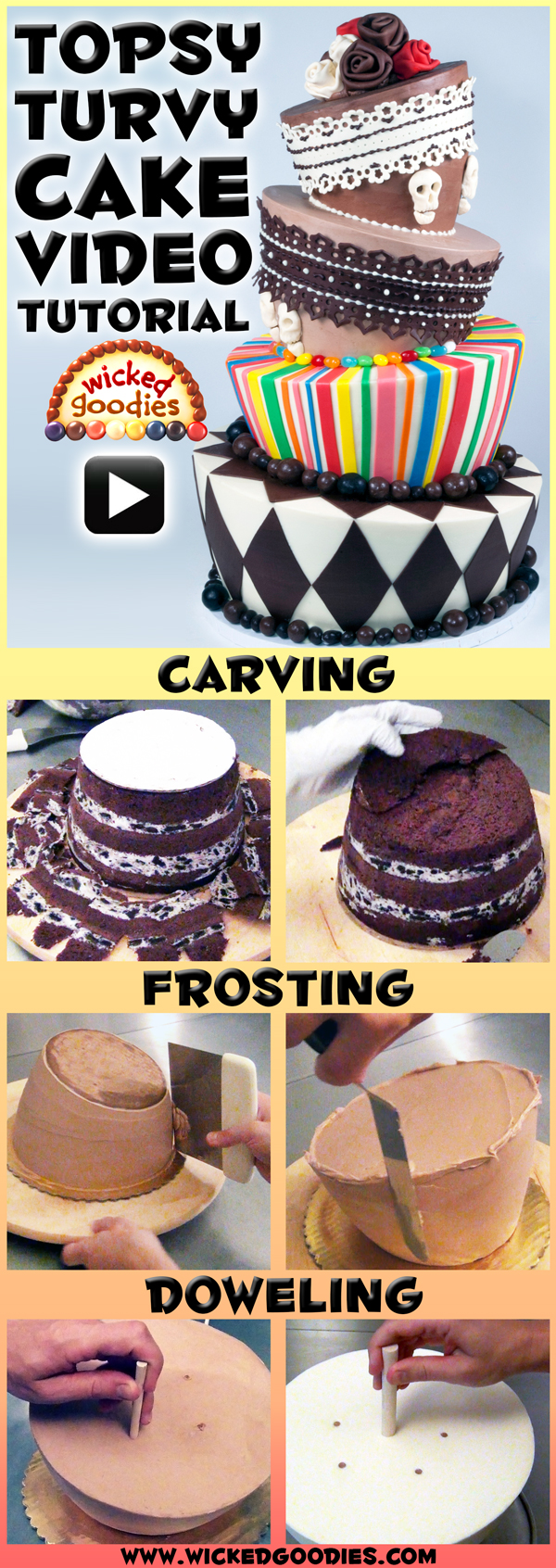
The topsy turvy cake, also known as the wonderland cake, mad hatter cake, or falling down cake is a popular cake design technique that involves carving and the physics of counterbalance. This tutorial demonstrates how to carve and assemble a topsy turvy cake using a minimum amount of knife work and a very handy upside-down method.
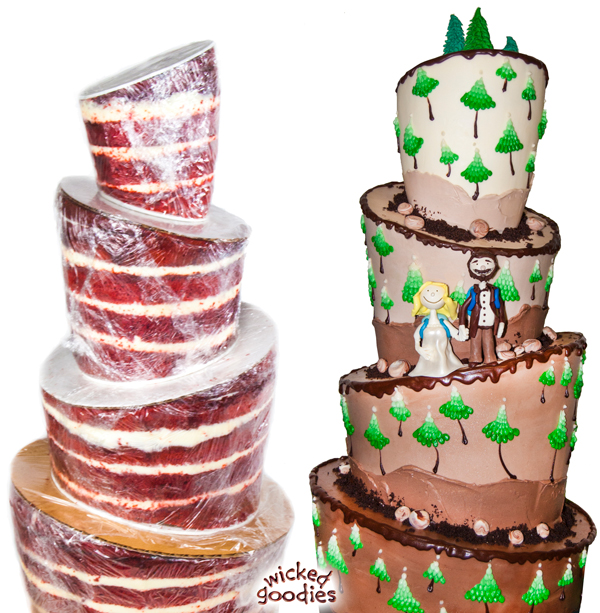
Topsy Turvy Cake Basics
VIDEO #1: Topsy Turvy Cake Intro
The topsy turvy cake method is similar to the ancient sculpting technique, contrapposto, which in Italian means counter pose. That is how a sculpted human form like Michelangelo’s 14-foot statue of David remains stable without keeling over.
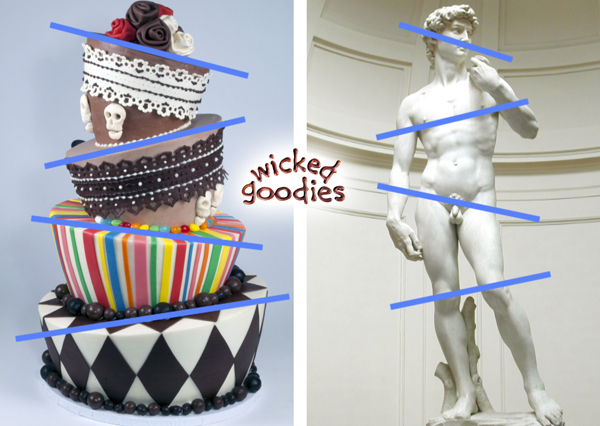
The key is counterbalance. Note how both structures involve wedge shapes. As long as each wedge counters its neighboring wedges, the weight distribution remains stable and the structure won’t topple over. This video series includes tutorials on how to carve, frost, and stack a topsy turvy cake.
I recommend starting out using this professional method of filling and assembling cakes in the pan.
How to Fill Layer Cakes in the Baking Pan
I use an upside down carving and frosting method so the cake cardboard that goes on top is eventually going to represent the bottom. This cardboard should be at least one inch smaller than the cake to get a tapered effect. In this case, it’s two inches smaller in diameter than the cake itself.
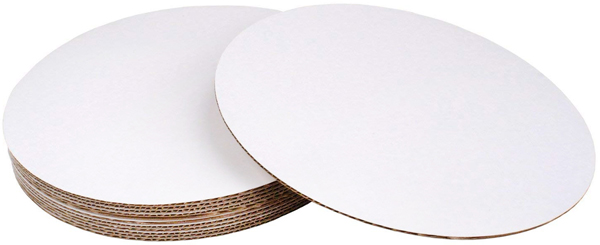
If you don’t happen to have the right sized cardboard circles then all you need is a compass and a ruler to cut whatever you need down to size. In this case, I begin with another set of cardboards that are the same size of the cake when what I want are circles that are two inches less in diameter than the cake.
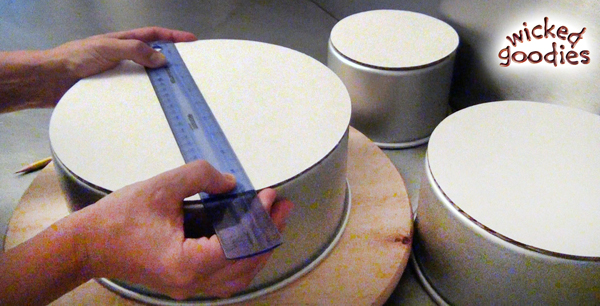
First, locate the center of the circle by measuring the diameter and marking a line in the middle. Then, turn the board 90 degrees and do the same thing, again marking a line in the middle. Wherever those two lines intersect is the best approximation of that circle’s dead center.
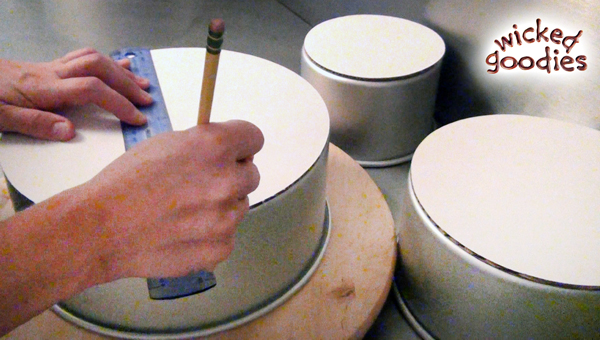
Second, measure the amount that you want to carve off. In this case, since I’m tapering a total of two inches off the base of the cakes, I measure one inch on each side of the circle.
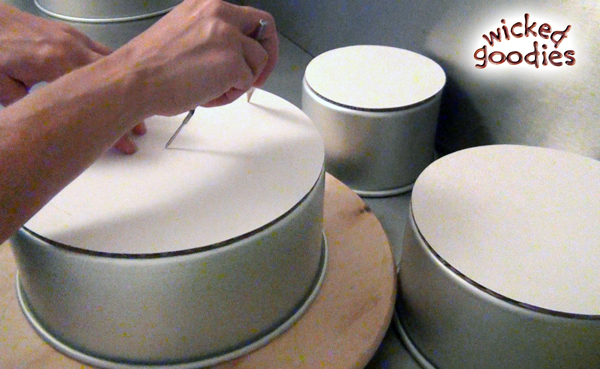
Third, plant the point of a compass into the center point and open it to reach one of the side markers. Use that bearing to then draw around with the compass. The result should be an exact circle that is two inches smaller than the cardboard.
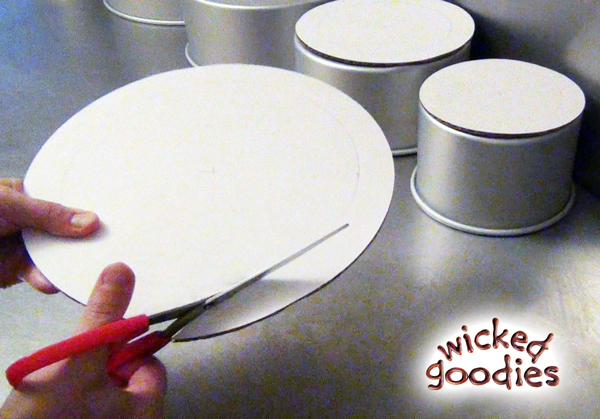
Fourth, use scissors to trim around that circle. Repeat that same process on the rest of the cardboards until there is a bottom board for every tier of the cake.
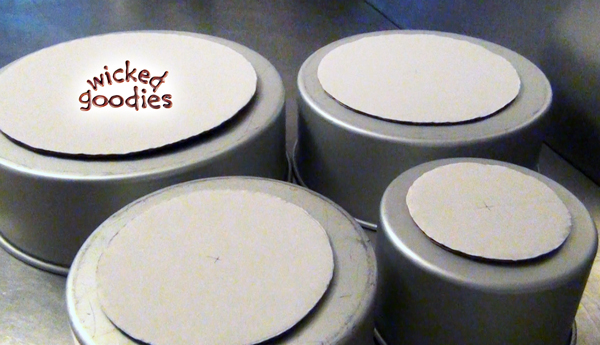
Topsy Turvy Cake Carving
VIDEO #2: Topsy Turvy Cake CARVING
Topsy turvy cake carving involves two stages: tapering & wedging.
Carving Step #1 – TAPERING
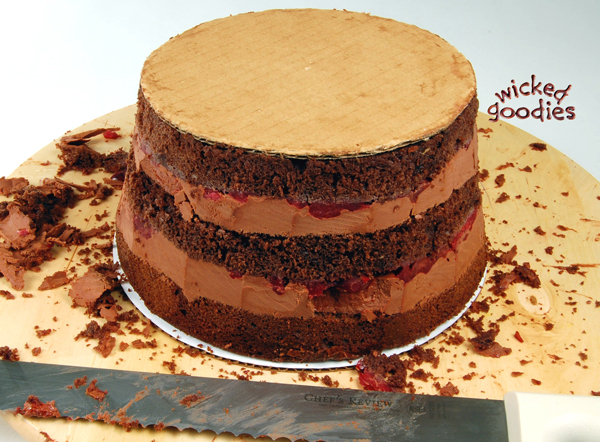
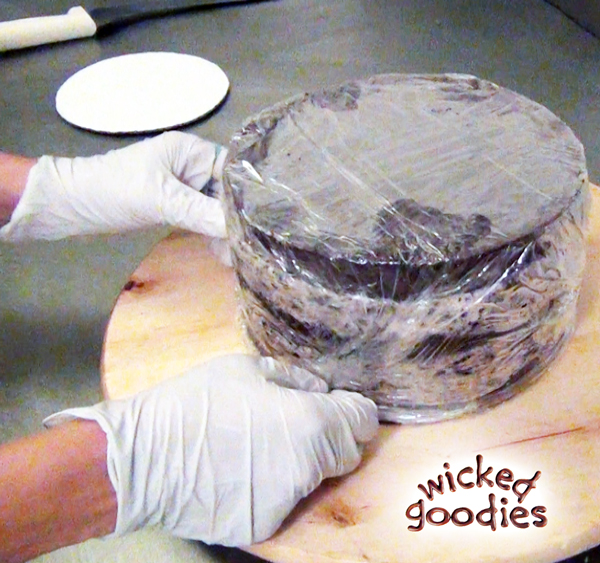 Begin with a semi-frozen cake. I suggest beginning with one of the middle tiers as the medium size is usually easiest to handle. Once you get the hang of it, you’ll be ready for the smallest and largest tiers, which are more challenging. Here is the cardboard that’s the same size of the cake, which goes on the bottom now but will ultimately be on top.
Begin with a semi-frozen cake. I suggest beginning with one of the middle tiers as the medium size is usually easiest to handle. Once you get the hang of it, you’ll be ready for the smallest and largest tiers, which are more challenging. Here is the cardboard that’s the same size of the cake, which goes on the bottom now but will ultimately be on top.
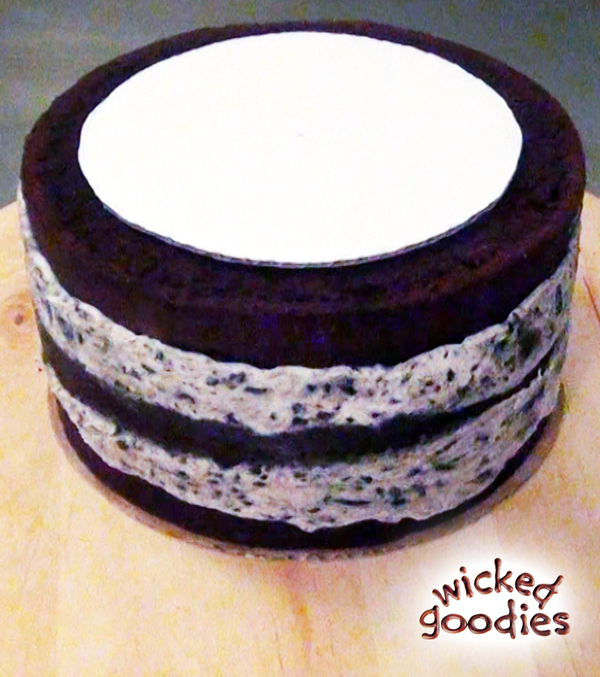
And here’s the cardboard base that will ultimately hold up this cake from the bottom. Because this process happens upside down, the cake is now on its head.
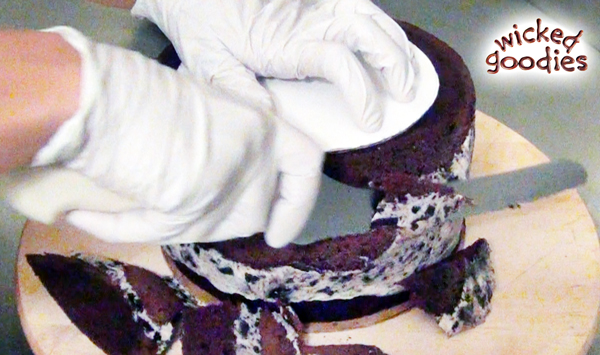
Using a serrated knife, carve the cake on a diagonal starting from the cardboard’s edge, using the two cardboards as guides. Hold the smaller cardboard in place on the top of the cake so it does not slip around. The first stage is to remove the ledge that’s surrounding it. Now because this cake is frozen so it’s harder to cut but the advantage is that you can cut at a very precise angle all around.
Clear off the bulk of the scraps and put them into a bowl.
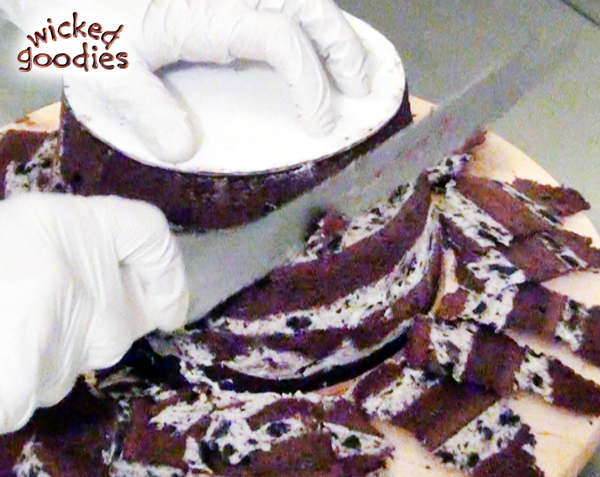
Once the bulk of that edge is removed, dig in more to straighten out the sides. Towards the end, run the knife in long sawing motions across the sides of the cake to shave off any last bits that are sticking out. Again, clear off the scraps and put them into a bowl then seal that bowl with plastic wrap and put it into the refrigerator.
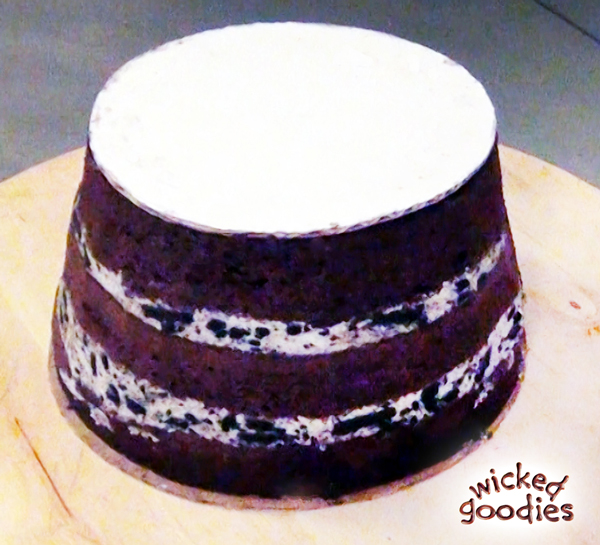
Carving Step #2 – WEDGING
First, Wedge the Top (which is really the bottom)
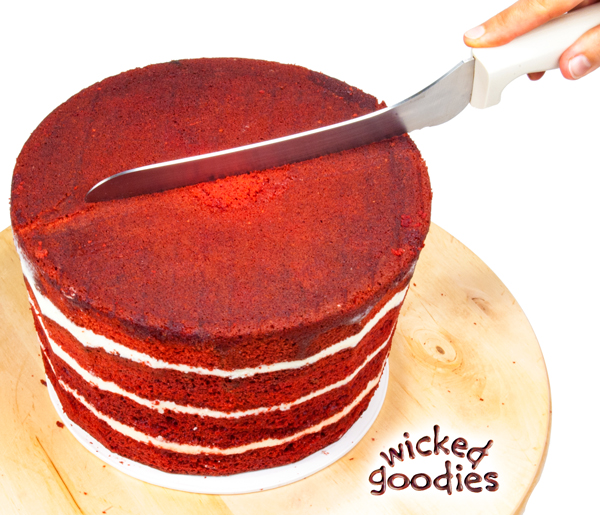
Remove the smaller cardboard and push the knife gently just into the ‘top’ (which will eventually become the bottom) of the cake, right down the middle, to mark the halfway point.
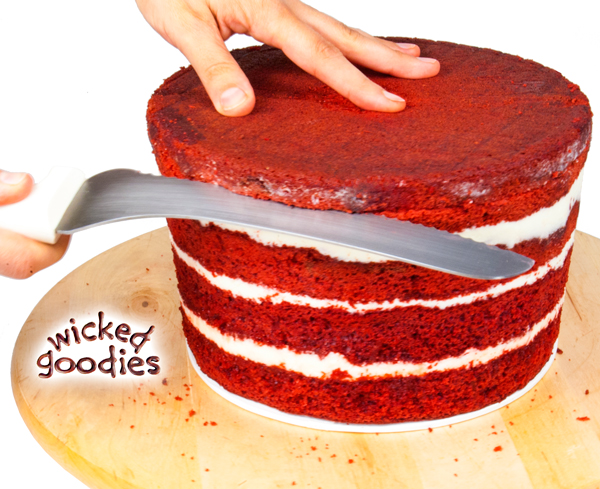
Then cut a half moon sliver out of the surface, on a bias. Be very careful of the free hand here. If you are not sure with the knife, wear a cutting glove on that opposite hand.
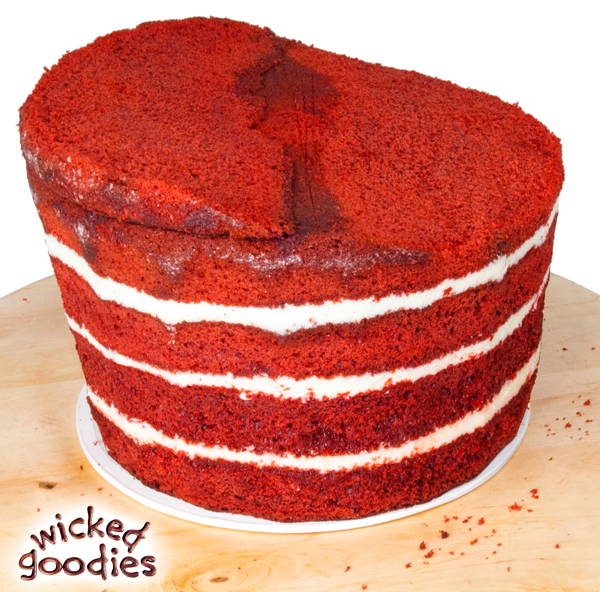
Once that sliver is removed, flip it around and press it into the mirroring side of the circle to extend the cake on that side. Trim and move around any bits of cake that are needed to make that surface flat.
Second, Flip the Cake Over and Wedge it Again
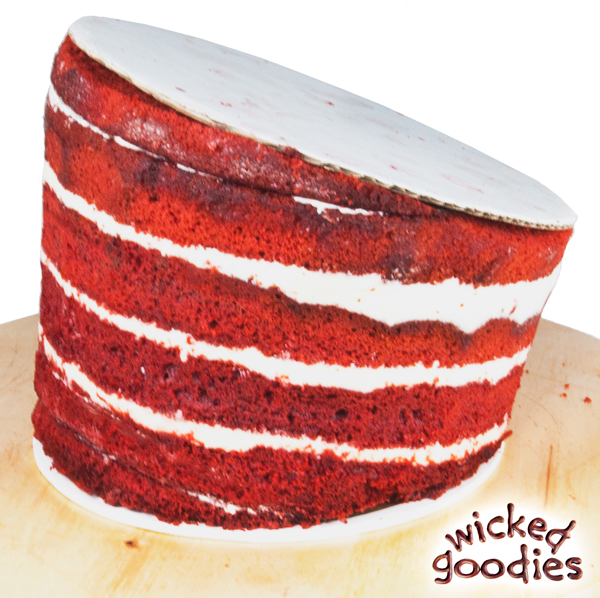
Press the smaller cardboard round into the ‘top’ of the cake and flip it over so the smaller end is on the bottom and the wider end is on top. Now, the cake is right side up.
Make a mark down the middle of the cake on the same axis that was just made previous. Cut a half moon sliver from the same side of the cake from which it was just cut previous. Build it into the same mirroring side of the cake as well. The results should be a cake tier that is both tapered and wedge-shaped, leaning off to one side. Press the larger cardboard circle into the top of the cake and wrap the whole thing in plastic wrap, still sandwiched between the two cardboards. Put it into the refrigerator and repeat this process on the rest of the tiers.
Topsy Turvy Cake Frosting
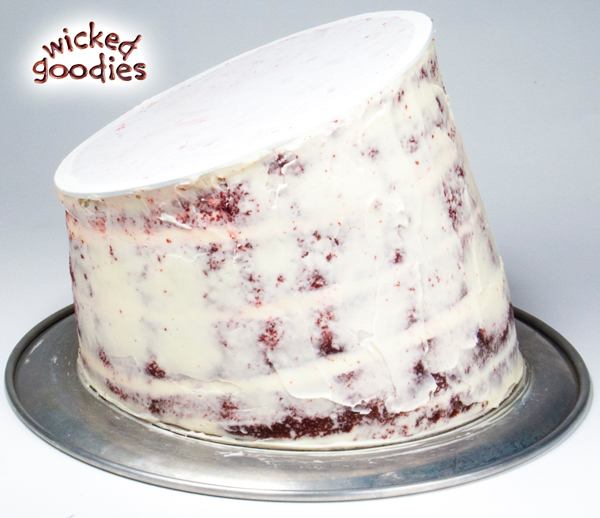
VIDEO #3: Topsy Turvy Cake FROSTING
The best way to frost a topsy turvy cake is upside down, because that positioning exposes the sides of the cake better, making them easier to access with tools.
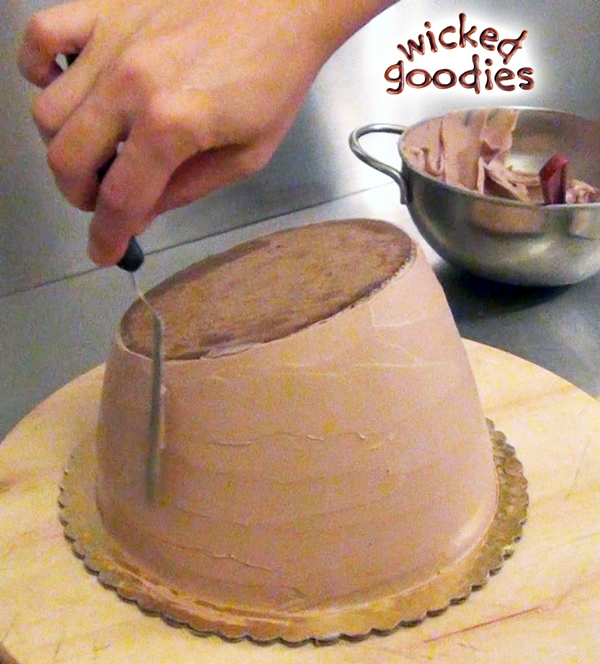
1. Continue here as with the carving of the sides by working on the cake upside down, keeping it sandwiched between two cardboards. Begin applying a crumb coat of buttercream frosting while pressing on the top of piece of cardboard with the opposite hand to maintain leverage with the cake. Do not frost on top of the cardboard and do not remove that top cardboard. Just hold it in place.
2. Once the crumb coat is complete on the sides, return the cake to the refrigerator for ten minutes or until the frosting is hard.
3. Next, apply a thicker finish coat. Note how much easier this is to do on an upside down cake. Now the finish will have spatula marks on it at this stage and that’s okay. Don’t waste time trying to perfect it. Instead, return the cake to the refrigerator for at least one hour or until the frosting is fully hardened.
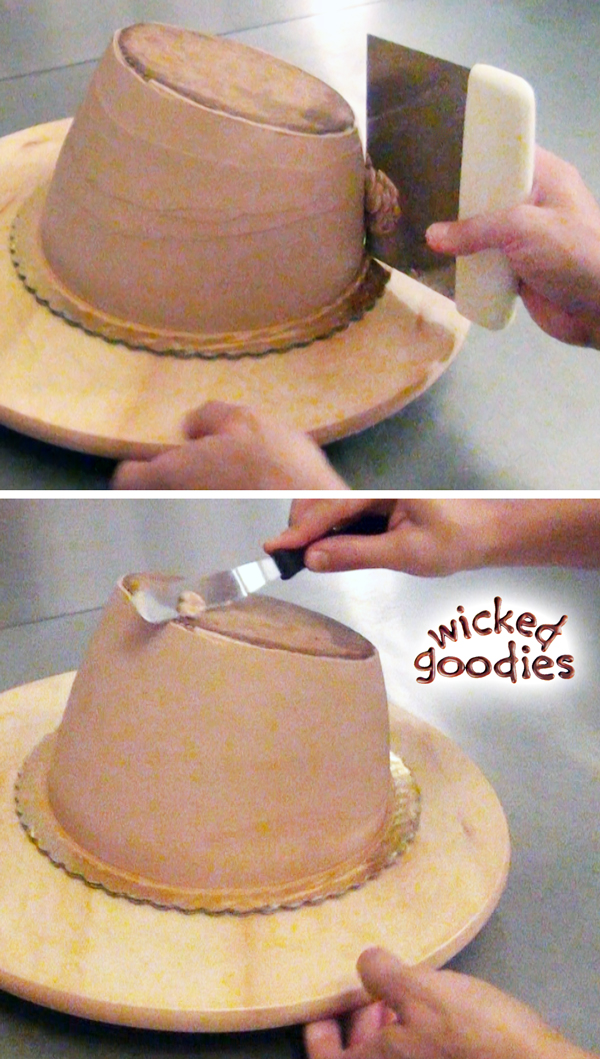
4. Once the frosting is hard, whittle it down to a smooth finish by spinning the wheel while working the blade of a bench scraper up the sides. Clean off the blade periodically. You can also use the blade to redistribute frosting if a dent or hole needs to be patched or smoothed over.
5. Return the cake to the refrigerator for ten or more minutes, until the frosting is fully hard again.
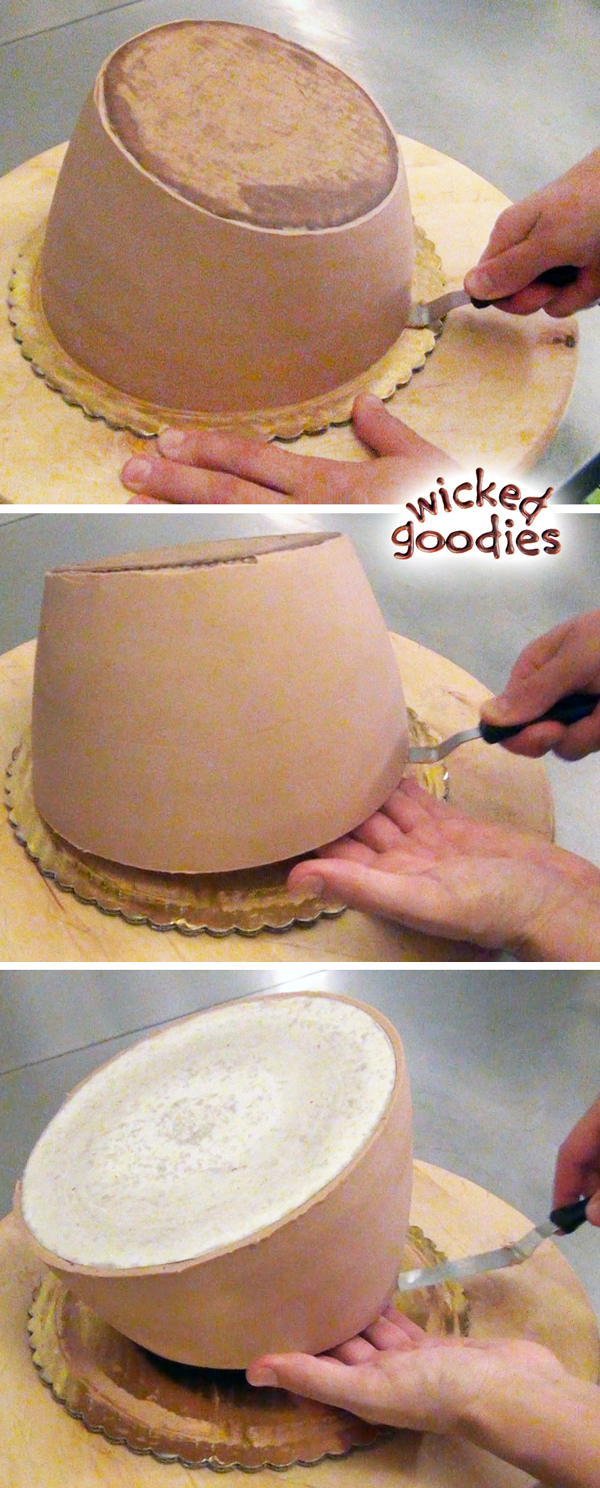
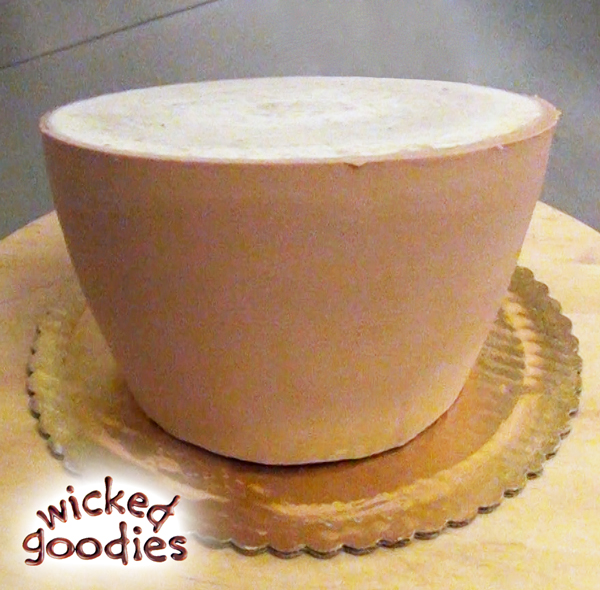
6. Once the frosting is set, run a small offset spatula around the base of the cake to release it from its working platform. Press down against the board when doing this so as not to cut into the buttercream finish. Then flip the cake right side up. Clean any excess frosting off of the platter.
7. Remove the top piece of cardboard then add a thin crumb coat of buttercream to the top. Chill the cake until the crumb coat is hard.
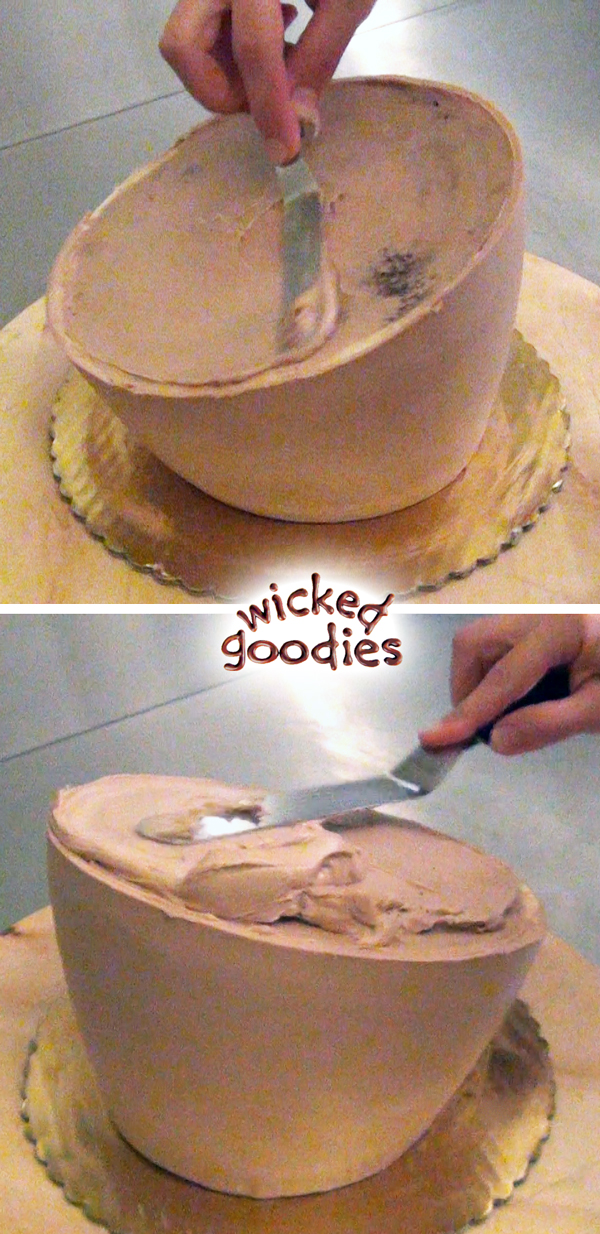
8. Add a second, thicker layer of buttercream, filling in the gap where the cardboard was. As long as the cake is well-chilled, it should hold its edge. Once the top is all filled in, use a medium offset spatula to level it off. Then, clean up the sides, making them smooth. A lip should form around the top edge. Level that off. At this point, it’s important to clean the spatula after every swipe. Use only the outside edge of the blade as that yields a smoother finish with less jagged spatula marks.
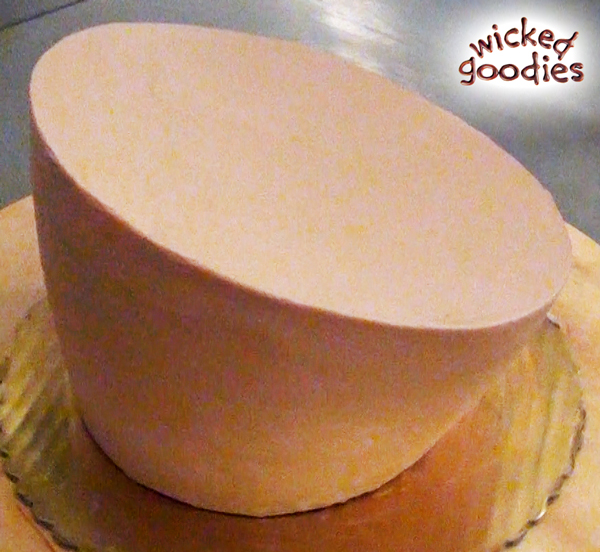
9. Return the cake to the refrigerator for at least one half hour before proceeding with the doweling and decorating.
Decorating a Topsy Turvy Cake Upside Down
If it’s possible to work it into your process, I recommend decorating the cake tiers while they are still upside down. The angle is easier to work with. In the mountain cake example below, I piped a green ombre fir tree design while the tiers were still upside down. I covered the rough edge with dripping chocolate.
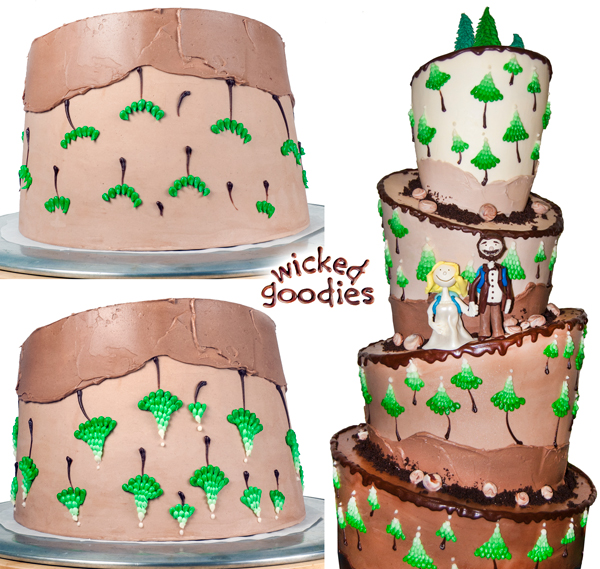
Topsy Turvy Cake Doweling
Video #4: Topsy Turvy Cake DOWELING
Once the cakes are frosted and chilled just enough so the buttercream is fully hard, it’s time to add the support infrastructure. I prefer to use wooden dowels, especially for topsy turvy cakes.
1. Mark the top of the cake where you plan to insert the dowels. The dowels should go ½ – 1-inch inside the outline of where the tier above will rest. In the video I’m eyeballing it but I recommend using a parchment paper guide that is the same size as the base of the tier that gets stacked above in order to position your dowels correctly.
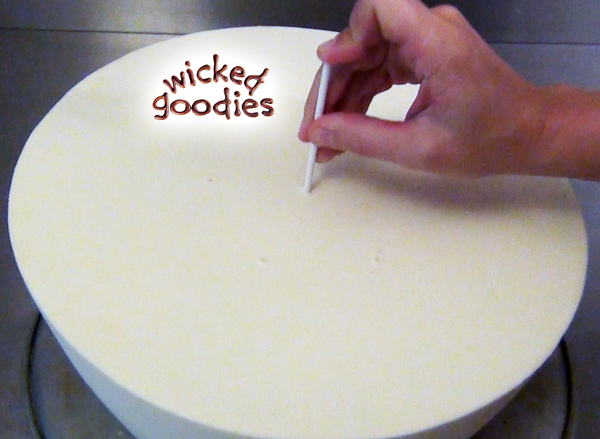
2. Insert lollipop sticks or long skewers into the cake. Insert them at a slight angle matching the slope of the cake. You want the dowels to be vertical once the cake is assembled so you have to account for the fact that this tier will be sitting on an angle.
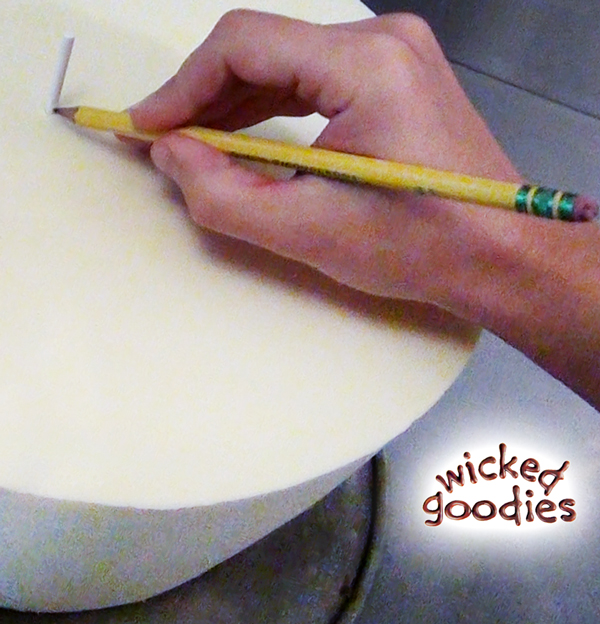
3. Mark the stick to measure the height of the cake. Since the cake is sloped, you will need to do this more than once since the height of some of the dowels will be different.
Remove the sticks from the cake. Be sure to keep careful track of which sticks go with which cake tier.
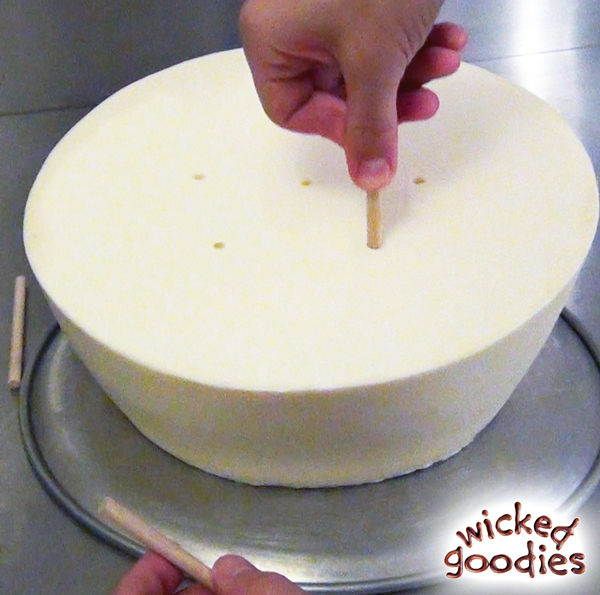
4. Use the sticks to mark wooden dowels then cut and sand them down to size. I recommend marking the dowels 2 millimeters shorter than the marks on the sticks so there is no chance that the dowels end up being too long. If the dowels extend beyond the surface of the frosting, that could compromise the cake’s stability once it’s stacked.
5. Make sure the matching dowels are true before inserting them into the cake. Press down on each one to make sure they hit the cardboard base.
For larger tiers that require a star configuration of dowels, some of the heights may match but it’s possible that they will all be different so each hole should be measured separately.
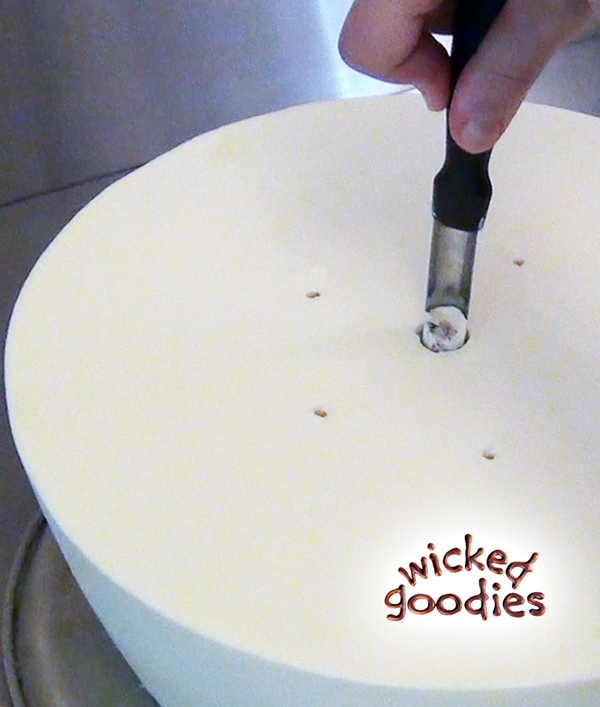 For the thicker center dowels, use a saw to cut them down to size. To make room in the cake for thicker dowels, I recommend coring out holes using bubble tea straws or an apple corer. If you don’t remove the cake that will be displaced by a thick dowel, you run the risk cracking the surface of the cake from excess pressure. Base tiers often require thicker dowels all around. Top tiers require no vertical support dowels since nothing gets stacked on top.
For the thicker center dowels, use a saw to cut them down to size. To make room in the cake for thicker dowels, I recommend coring out holes using bubble tea straws or an apple corer. If you don’t remove the cake that will be displaced by a thick dowel, you run the risk cracking the surface of the cake from excess pressure. Base tiers often require thicker dowels all around. Top tiers require no vertical support dowels since nothing gets stacked on top.
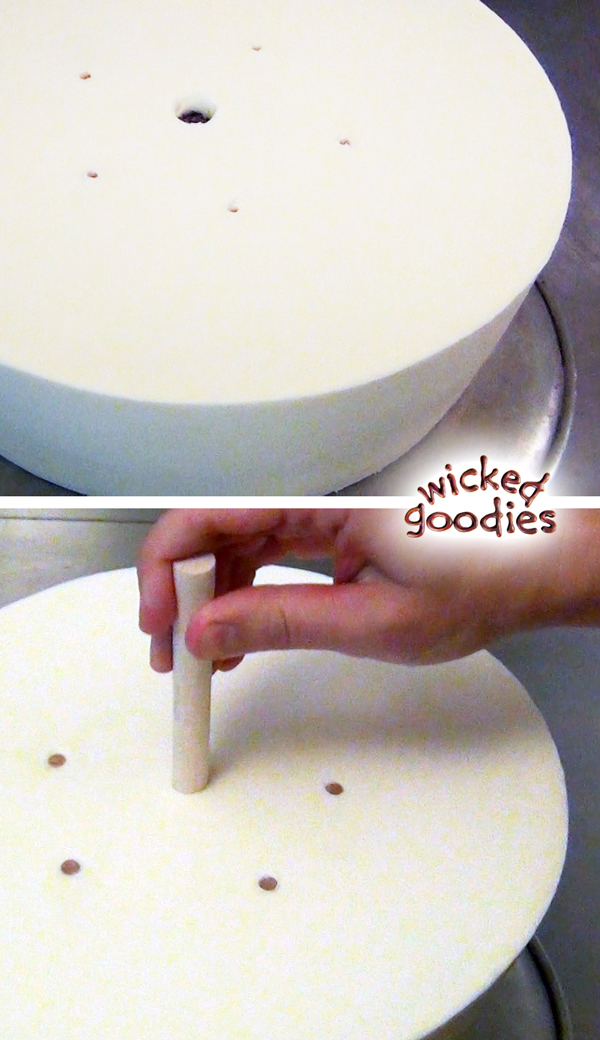
6. Once the dowels are all inserted into the cake tiers, I recommend decorating each tier separately before assembling the cake. I also recommend placing a piece of parchment paper on the top surface of each of the lower tiers. It should be the same size as the base of the tier that gets stacked above. This will help guide your placement as well as prevent the tiers from sticking together so you can shift them around if you need to when you stack them. It will also make it easier to disassemble the cake when it’s time to cut it.
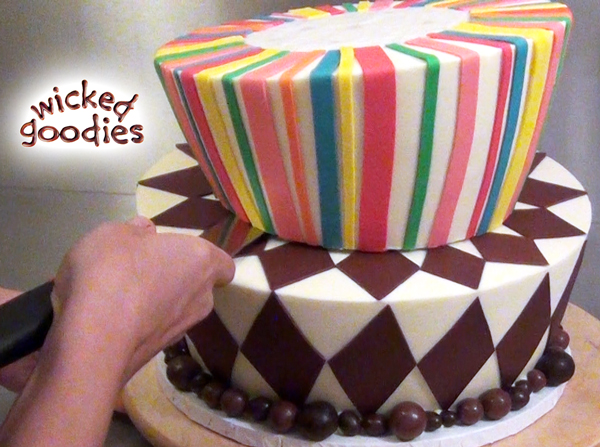 7. Once the tiers are stacked, secure them from shifting side-to-side by passing long pointed dowels through the cardboard into the tier below. You may need to use a hammer to penetrate the cardboard. I call this type of dowel “horizontal supports” since they prevent the tiers from shifting horizontally.
7. Once the tiers are stacked, secure them from shifting side-to-side by passing long pointed dowels through the cardboard into the tier below. You may need to use a hammer to penetrate the cardboard. I call this type of dowel “horizontal supports” since they prevent the tiers from shifting horizontally.
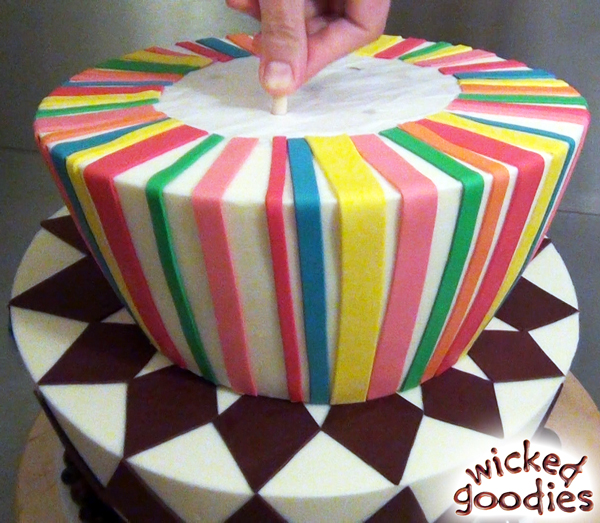
Once all the tiers are stacked with pointed dowels holding them securely in place, you may add the topper.
Topsy Turvy Mountain Cake Example
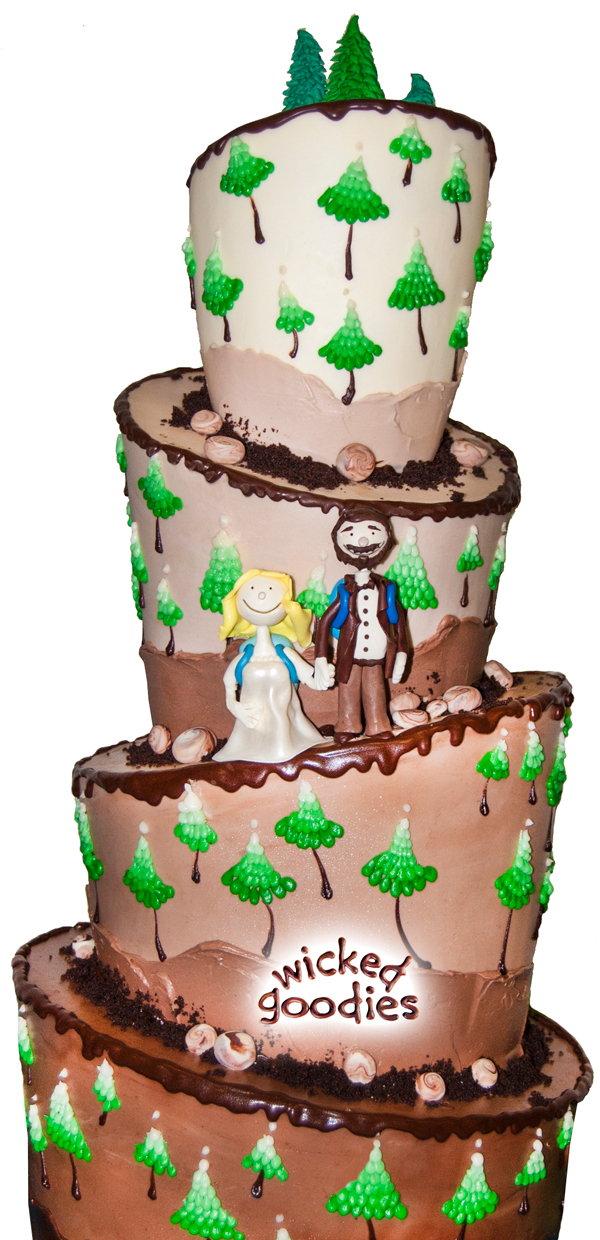
The 4-tier red velvet cake that appears here served 100 and consisted of the following levels, all of which began as cylinders that were 5” in height before carving.
- 5” diameter round top tier (tapered down to a 4” diameter base)
- 7” diameter round tier (tapered down to a 6” diameter base)
- 9” diameter round tier (tapered down to a 8” diameter base)
- 11” diameter round base tier (tapered down to a 10” diameter base)
These measurements are for a skinny topsy turvy look. For a more squat, Alice in Wonderland cake shape, opt for wider tiers that are 3” or 4” apart from one another in diameter.
Items needed to carve this 4-tier skinny topsy turvy cake (note: if you don’t own all these sizes of cake circles, use a ruler, compass, and pencil and to trace their outlines and trim them down to size).
- 4” diameter round cake cardboard
- 5” diameter round cake cardboard
- 6” diameter round cake cardboard
- 7” diameter round cake cardboard
- 8” diameter round cake cardboard
- 9” diameter round cake cardboard
- 10” diameter round cake cardboard
- 11” diameter round cake cardboard
- Serrated knife
- Plastic wrap
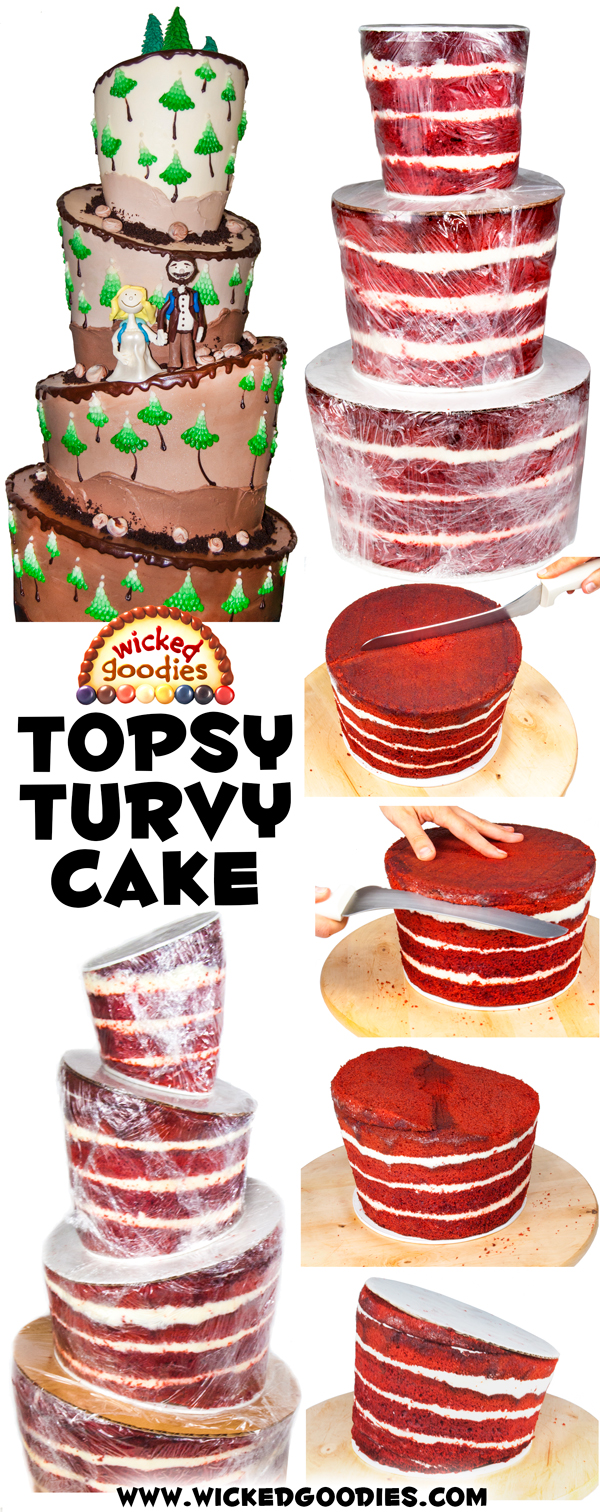
1. Taper each tier using my upside down cake tapering method.
2. With a serrated knife, saw across the middle just enough to mark the top of each cake.
3. Angle the knife 15° and slice a half moon wedge off ½ of the top. Start and end the cut shallowly but arch downwards in the middle to slice ½” – ¾” deep.
4. Flip the wedge of cake onto the opposite side to complete the angle. Secure it with a thin layer of buttercream frosting.
5. Return the appropriate-sized cardboard to the top of the cake, press, and flip the cake upside down.
6. Repeat the same process on the bottom of the cake, cutting from the mirroring side and building onto the mirroring side so that the end result is a tilted cake that is wedge-shaped.
7. Repeat the process on all tiers. Store the tiers wrapped in plastic with the cardboard circles on both top and bottom at all times. The cardboard will help each tier hold its odd shape.
► For a cake that requires a level surface for a topper, refrain from angling the top end of the top tier.
8. When all the tiers are carved, stack them as they are meant to be assembled to test their balance and approve the overall angle of the cake. They should be able to stand alone without any help. Carve adjustments at this stage if needed.
9. Frost the tiers with smooth buttercream using the same upside-down method from How to Taper Cake Tiers.
10. For topsy turvy infrastructure, I have used both the dowel system and the SPS system successfully many times. My preference is the dowel system. There is more measuring involved because the interior supports are at different angles but it follows the same rules as an ordinary stacked cake.
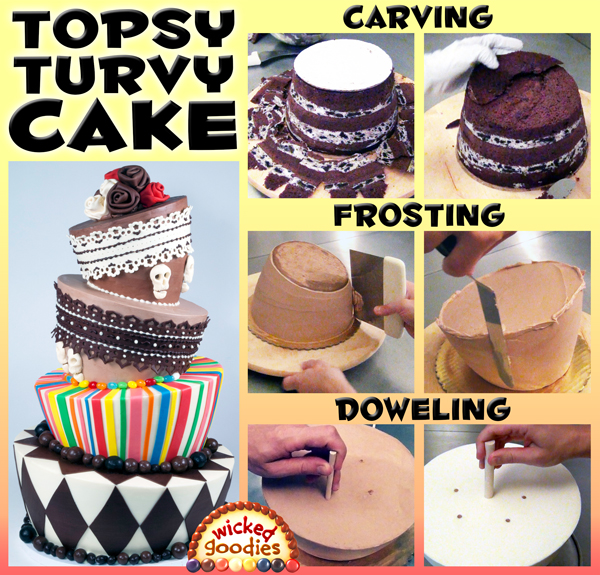

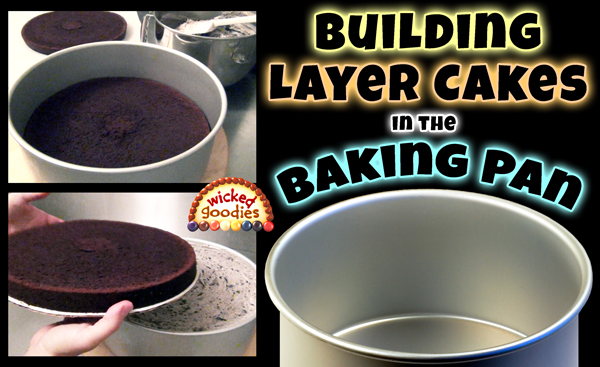
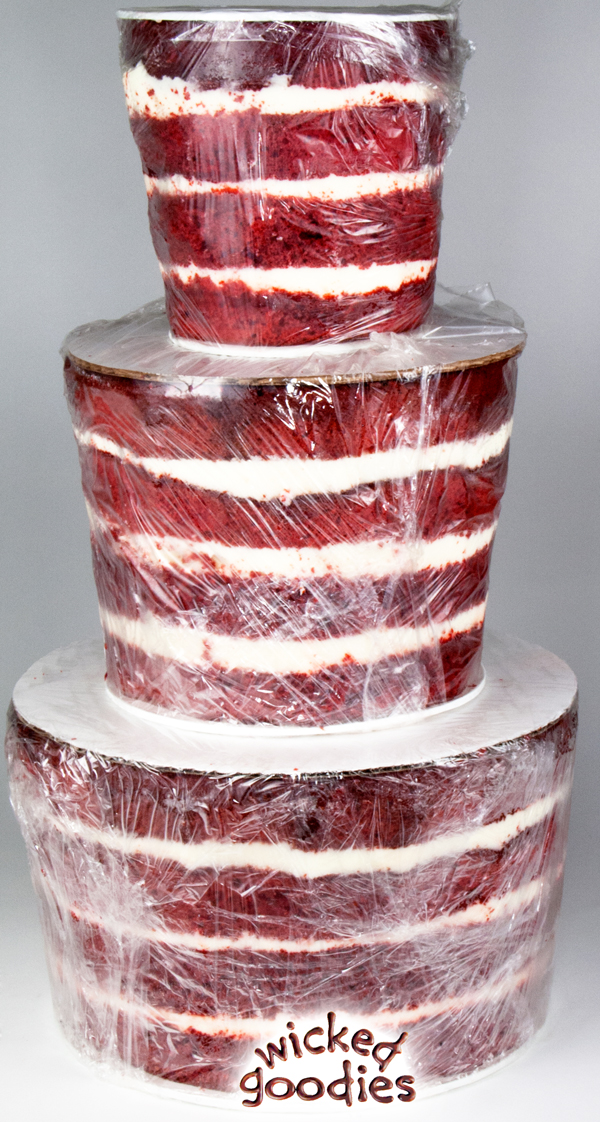
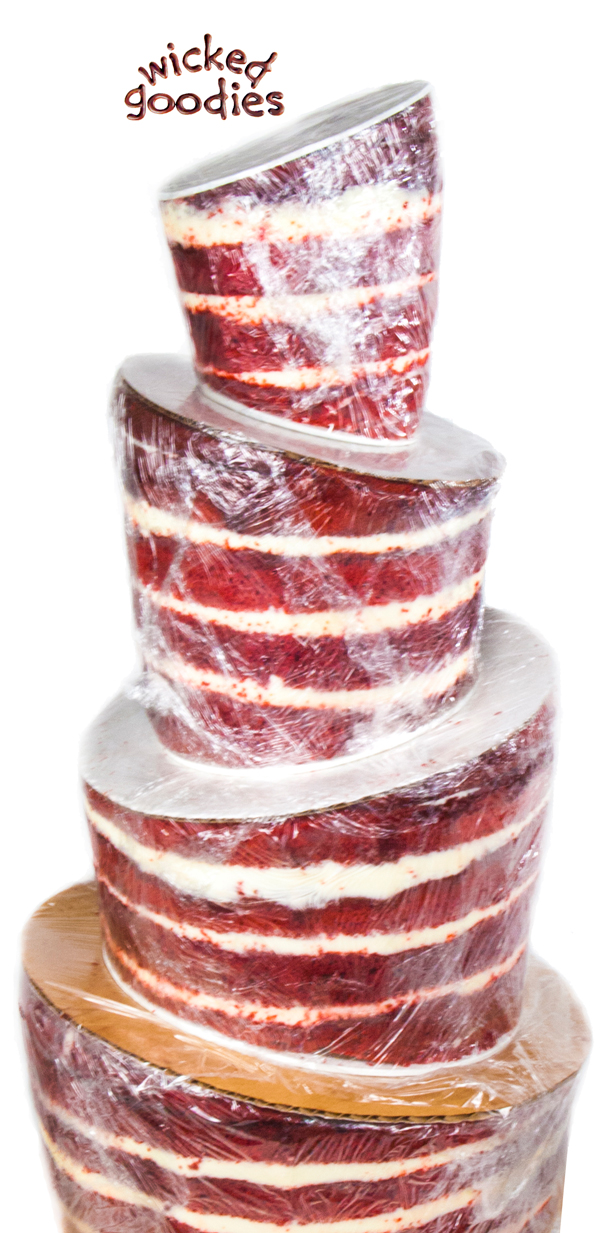
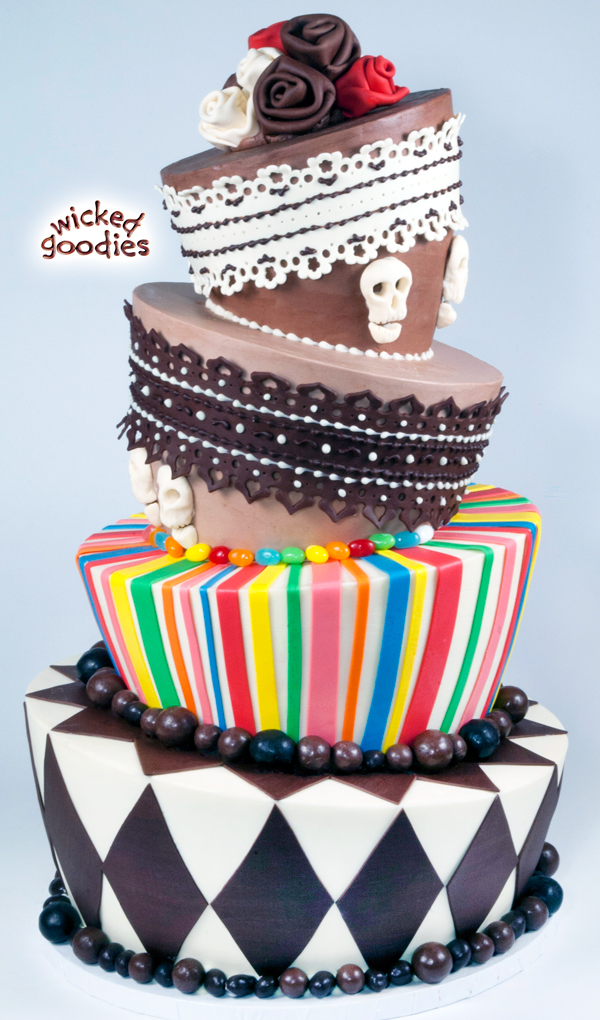



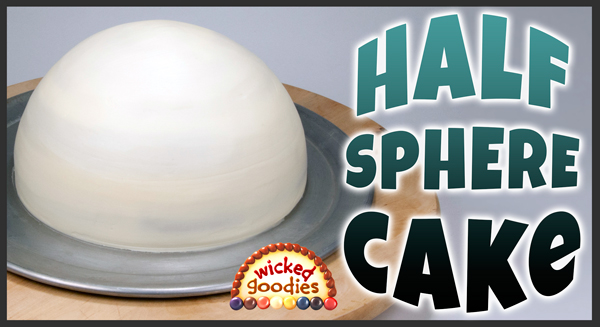
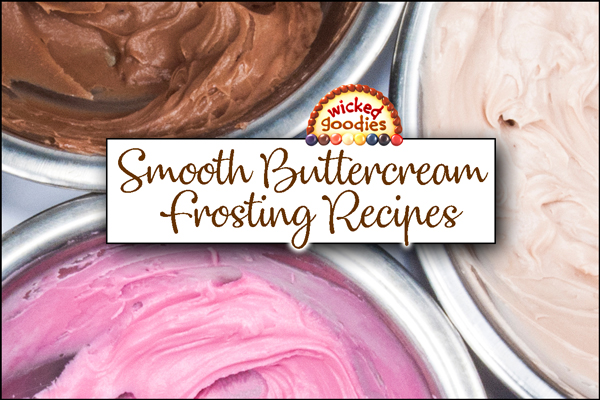
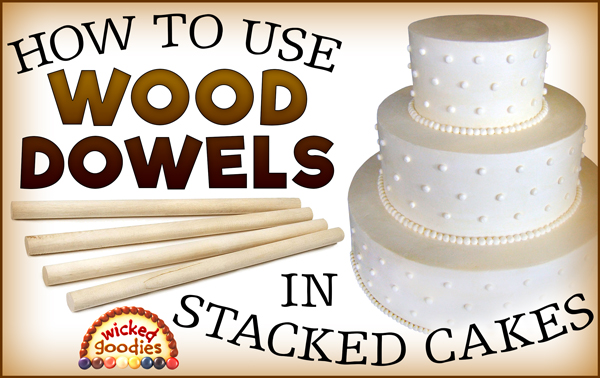
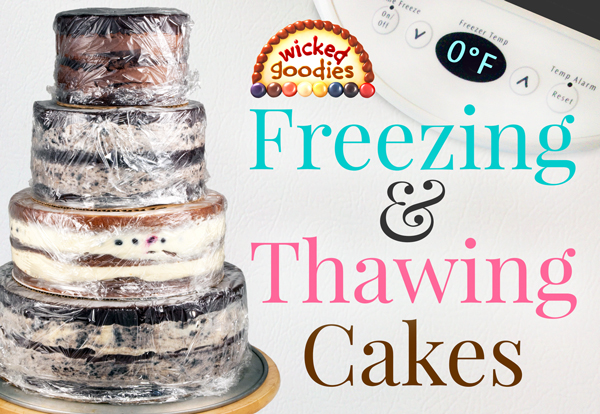
Wanted to say thank you for such an excellent tutorial for making a topsy turvy cake! I took on the challenge this weekend for my niece’s 2nd birthday and it turned out beautifully! Do you have an Instagram? I’d love to tag you on the photos I posted there!
Love your tutorial! The best by far.. I have a mad hatter topsy turvy cake due soon.. what tiered cake sizes do you recommend for party serving of 60, being that this requires a lot of trimming down?? Thanks for the assistance
Hello
Quick question:
Was the bottom of the 11″ tier carved as well? Looking at the photo, it looks pretty flat/level. Looking forward to your assistance.
Yes – it was tapered and angled on the top side only. Not on the bottom side, so that it sits level.
Thank you!!!
🙂
Am I to understand that u set up a Topsy Turvy Cake & THEN Cover with Fondant?? Seems difficult! Is there a Tutorial that shows this specific method of Covering? Is there 2-3 methods for Topsy Turvy? The 1st I saw demonstrated was carving the cavity Out of cake (Too Time Consuming &TOO Much Cake & I felt I’d Never get the price vs labor) I wondered if u couldn’t do it similar to the above method Bt I missed a step?? I’ve also seen Topsy Turvy Pans? Could you or others comment. I see decoratora in Michigan only charging 5-10% over a Sculptured Cake & Topsy Turvy seems to be More Cake & Much more work & Delivery Effort-how should they be Priced over other Sculptured cakes?
Yes – it is more difficult to cover this shaped cake in fondant due to the sharp angles. Indeed, there are several methods for making topsy turvy cakes – this is the one that I find to be the least time consuming. I agree that the technique of carving a cavity out of the cake complicates matters significantly so I don’t recommend that one. As for topsy turvy pans, they also complicate things since they are only sloped and not tapered, which means when it comes time to carve the taper, you start out with a sloped cake. That makes it more difficult to achieve an even taper. Basically what the pans help you do is the easiest part of the whole process so there is really no point in investing in a pan set.
You can find my topsy turvy cake price recommendations here. In the Cake Sales Kit, I go into more detail about why this cake must be priced higher. That kit also includes sizing charts for topsy turvy cakes based on the above method.
when taking your fondant covered Saran wrapped cakes out of the fridge so you let them come to room temp before removing the Saran Wrap or do you take it off immediately after removing from fridge?? Thank you for sharing your tips and tricks your cakes are truly incredible!
For a fondant covered cake, you can leave the plastic wrap on until the cake arrives at the party and is ready to go on display. However if there is chocolate piping or some kind of decoration that should not be covered in plastic, then you want to leave the plastic wrap on right up to the point when the decoration gets added.
Hi Kristen, me again!
Two questions please:
1) Does every tier get flipped upside down after the wedge has been carved ? Could not work out why in my brain..
2) Can I assume that you refrigerate your fondant covered tiers? Do you put them in boxes or just wrap with saran wrap? Thanks again. I’ll be sure to post a pic of my mardi gras topsy turvy cake.
Here is my topsy turvy cake!
Sally,
Amazing! That looks like a perfectly executed topsy turvy cake! Kudos! Thanks for sharing a photo of your wonderful work! I’m sorry that for the second time, my website filtered your comment out so I didn’t get an email about it. I am just now seeing your original post. Looks like you figured it all out but here are the answers to your questions:
Yes, every tier gets flipped upside down.
Yes, I refrigerate the fondant or modeling chocolate-covered cakes sealed with plastic wrap to prevent condensation from forming on the surface and making it gummy.
Again, excellent work!
Thankyou made interesting reading I am making a topsy turvy 3 tiers bottom will be fruit cake and marzipan covered with fondant .the top a light fruit cake and the top a chocolate.do I follow the same method suggested .any tips to transport the cake
Hi – I haven’t completed the material on how to transport this type of cake yet but I hope to release it some time this year.
Hi
I will be making a 2 tier topsy turvy birthday cake soon, can i ice and decorate the cake the day before the party?
Yes! For sure. Good luck and please share pics when you’re done!
Best tutorial I have seen so far for a topsy turvy cake! Thank you for making it so understandable.
well done for making that cake xxxxxx
do we have a particular cake tin for topsy cakes?
I use these cake pans for everything, including topsy turvy cakes.
Just wondering how you do this with the SPS System
When working with SPS, don’t angle the tiers too much when carving them. I recommend using a pipe cutter to trim the columns (See photo below). You have to cut on a bias and this tool makes it easier. It’s very important to set the cake up on site and not attempt to assemble it before delivery.
However SPS is not my recommended method for stacking cakes, especially topsy turvy cakes, since the plastic plates prevent you from being able to insert a center dowel. This can become a problem over the course of a display period if the cake table is a little tilted or the cake is not 100% level. With SPS, all it takes is for one tier to start shifting and the whole cake can go down. SPS also creates a sizeable gap between cake tiers, especially in the case of topsy turvy cake because the columns are different lengths so the plates might not sit right, and that can be extremely de-stabilizing.
I once worked in a busy cake bakery that stacked all their cakes using SPS and there were a lot of problems, especially with topsy turvy cakes. The percentage of failure was too high in my estimation.
You don’t have to worry about the tiers slipping apart if you use my my preferred wood dowel method for stacking cakes.
I am making a topsy turvy cake today using this method for a party tomorrow. My one question after reading all the different methods used, is how to cut the dowels at the top end. Im assuming they will all be different sizes due to the angle at the top of each layer. Do you cut each dowel for each layer individually or measure the angle or eyeball it??? Terrified of a collapsed cake!
Marissa, I push lollipop sticks or long thin skewers into the cake where I’m planning to put dowels then mark them to measure the depth then pull them out and use them as guides for cutting the dowels. You do have to measure a lot more lengths due to the angle of each tier. Then you also need longer, sharpened dowels to pass through 2 tiers at once to secure them together. Here is my tutorial on how to use wood dowels as infrastructure: http://www.wickedgoodies.net/2010/08/how-to-use-wood-dowels-in-stacked-cakes/ It’s not specific to topsy turvy cakes but it will still give you some pointers. Good luck! – Kristen
I love this tutorial. I just have a quick question. How do you insert a dowel through the whole cake if the tiers all have cake boards?
To insert a dowel through a stacked cake including the cardboard bases of each tier, sharpen its tip using a pencil sharpener and hammer into the cake. Just to be clear, in this case, the cardboard on the top of each tier is discarded after frosting.
Love your cakes!
Thank you for the instructions:)
Thanks and you’re welcome! 🙂
is it necessary to taper the cakes
Not if you don’t want to, no.
Great advice and tutorial!! I’m a beginner at cake baking and decorating. It’s going to take me yearssss to reach this level! 😀
Thankyou that is very helpful advice.
Hi, I am doing a Halloween themed topsy turvy cake for my son’s wedding and have to transport it 16 miles. I really want to assemble it before I take it but am really worried about the vibration during the car journey, as I have read lots of reviews regarding transporting these cakes and lots of people have had disasters!
You are definitely better off transporting the tiers separately when it comes to a topsy turvy wedding cake. I usually assemble the first two tiers of a stacked cake in the kitchen (with dowels holding them securely together) then complete the cake on location. As long as the cake elements leave your place at refrigerator temperature and you keep your vehicle nice and cool during transport, the tiers should stay intact for an on-site set-up. I’ve found, especially with topsy turvy cakes, that if you insert a sharpened center dowel into the top tier before placing it on the cake, that permits better leverage and makes it easier to get it centered properly (the top tier is always the hardest to place on a topsy turvy cake). Then you push that dowel through the tier below to hold the top tier snugly in place. Good luck! Happy wedding to your son and to you, the MOG (mother of the groom)! 🙂
I can’t thank you enough for this tutorial!!!!! I had read others which all recommended carving out holes on the top of each tier to inset another tier. The results looked a bit “raggedy” and not what I wanted to achieve.
Your tutorial was straightforward and the step-by-step photos were a great help. Even though I was slightly frightened by the idea of physics and contrappusto!!!!!
The end product was an outstanding success (even if I say so myself!)
So thank you, thank you, thank you, thank you, THANK YOU!!!!!!!!! You are wonderful 😉
Paula, you are incredibly welcome! :)I’m so glad that this helped you.
Did you bake 4 layers for each tier, or is it just two layers cut in half and filled with buttercream, for instance would I bake 2 10 inch cake layers or more per tier??
I actually bake one big cake then cut it into 3-4 slices. You can read how I do it here: http://www.wickedgoodies.net/2013/07/how-to-slice-cake-layers/
I love your tutorial. It’s very easy to understand, but I have 1 question- I have done the topsy turvy by cutting into the tier below and making a shelf to hold the tier above it, is that still necessary if I follow your method or could I do it in conjunction with your method?
Tami,
You do not need to carve a shelf into the cake if you follow this method. Carving a shelf is quite tedious and unnecessary. This is much easier!
Im new to fondant, heck the entire baking a tiered cake really. I wanna make something special for my daughters 16th bday. Hope you can give some advice. so following your advice on how to make a topsy cake how long do you leave it wrapped and where? My fridge wont hold a 2-3 teir cake, lol. Also do you unwrap and take apart to place fondant on each level/decorate, then replace tiers? I’m thinking of using a cookies n cream buttercream frosting or chocolate chip mint one between layers would that be a problem you think? Also colors of fondant will be varied red, white, black, green..
Any advice would be awesome. Ive made marshmallow fondant once already was challenge but managed a basic two teir round. so hope this time I get just as lucky, lol. Great website thanks..
Christina,
I start topsy turvy cakes 3 days in advance of the event. Here is the way I go about it:
Day #1 – bake and fill the cakes, wrap them in plastic, and freeze them overnight.
Day #2 in the A.M. depan the cakes, carve them while they’re still quite cold, crumb coat them, wrap them in plastic, then let them thaw out in the fridge.
Day #2 in the P.M. once cakes are defrosted, apply finish coats of frosting and insert dowels or preferred method of infrastructure.
Day #3 – Apply finishing touches on cake, assemble bottom two tiers, transport cake to venue, then assemble final tiers on site.
– If a cake is wrapped in fondant or modeling chocolate, keep it covered with plastic wrap up until the last minute to prevent condensation from forming on the surfaces.
– Cookies and cream filling will work as long as layers of filling are thin and filling is thick and resilient, containing butter or egg yolks or gelatin. I would not recommend using just a whipped cream filling, especially an un-stabilized whipped cream filling. Perhaps with a generous amount of whipped cream stabilizer (i.e. powdered egg whites), it could work, but I have not tried it myself.
– White, red, black, and green are very bold colors. Be careful of using such bold colors on a white canvas as they are more prone to bleeding.
– Cakes take up lots of space in the fridge. If you want to make a tiered cake, you’ll have to throw out all the old food in your fridge, jam your still-good food into the drawers and door shelves, and tell everyone in your household to stay outa the fridge! Because there’s a topsy turvy cake in progress.
– Good luck! I hope this helps.
brilliant tutorial..plain and simple instructions so easy to follow will definitely be giving this a go ..thank you so much
Quick question – what kind of cake do you typically use for this? No matter what I do I cant get this to work right. I always end up with one side cracking and sagging when I construct. Wondering if I’m not using a dense enough cake
I’ve used this method at bakeries that had all different kinds of cakes – from airy genoise with soaking syrup to dense pound cake with fudge filling. The trick is to carve cakes while they are semi-frozen/very cold. That way, they don’t crumble apart.
Great instructions, love it!
Just one question, do you leave the card board circles on either sides of the cake even after decorating with butter cream / fondant? In other words, the person cutting the cake will have to know to remove the card board circles before serving?
Sorry for the silly question, just curious 🙂
Not silly question at all! The boards on the bottom of each tier remain as part of the cake’s infrastructure. The boards on the top of each tier are removed just before crumb coating. Normally I would not bother with boards on top of any tier but in this case, they are necessary for the upside down carving and frosting method.
Super instructions! Five star! Best method from all my researches on how to perfectly build a topsy turvy cake!
Thanks a million!!! This looks doable, even for me!
Thank you! This is the best explanation I have come across about the topsy turvy cake construction. Everyone one says do this and then do that but they miss on the very important question as to WHY?
You satisfied the engineer within me by answering it all.
Thanks and keep up the good work.
Por favor si me lo puede enviar en espanol a mi pagina, Graias mil, espero por ustedes.
Thank you.
esta muy bien el tutorial abra que probar acerlo